Quick Navigation
Things may seem complex when you try to fix the iOS update problems by yourself. If you are afraid of misoperation or have no idea what to do by yourself, using a third-party iOS system recovery program is a great alternative, for example, Passvers iOS System Recovery.
Amid great expectations of Apple users, the long-awaited iOS 18 has at last made its appearance. To get the iOS 18 profile downloaded, your iPhone needs to run iOS 16.4 or later. However, iOS 18-related updates may be trapped in something wrong, like a stuck download process. In this case, what can we do if iPhone won't update? To help you out, 8 workable solutions have been compiled in this post. Now, let's scroll down and dive in!
Part 1. How to Fix iPhone Won't Update Problems
iPhone won't update problems can be caused by different reasons and the fixes also vary. Here we provide 8 ways for you to try as well as to avoid data loss during the iPhone update, from basic methods to advanced ones.
1. Make Sure Your iPhone Is Compatible with the Latest iOS Update
Before you update your iPhone, remember to check if the new iOS system is compatible with your device. As listed on Apple's official website, the iOS 18 update supports iPhone XR or later models. That is to say, if your iPhone is newer than the iPhone XR which was introduced in 2018, theoretically it can be updated to iOS 18.
On the contrary, if your iPhone is an older model, it's a pity that you cannot do the update due to the incompatibility. However, you are recommended to take the minor updates in the current system which usually include security improvements.
2. Make Sure Your iPhone Storage Is Available
iPhone update failure can be caused by insufficient storage space. The iOS 18 update requires at least 4 GB of free space to download the update file. But usually, it needs more space for installation, so 10 GB storage space is recommended.
If there is not enough space on your phone, you can check your storage at Settings > General > iPhone Storage and manage the space to make it available for iPhone updates.
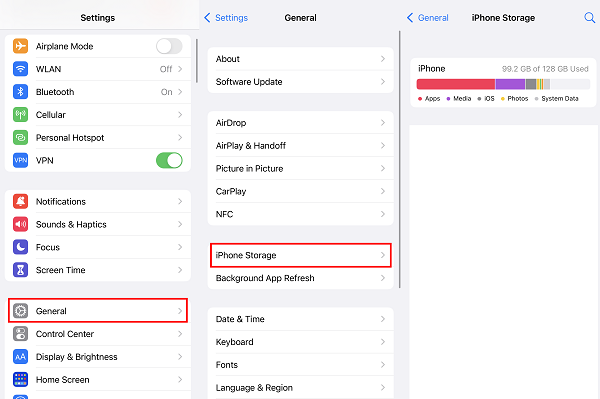
3. Make Sure Your iPhone Is Connected to the Internet
Internet errors can also cause an iPhone won't update problem or make your iPhone stuck on update requested. There are three ways to enable and check your network for the iOS 18 update.
Step 1. Go to Settings > WLAN > Enable your Wi-Fi network if you haven't turned it on.
Step 2. Go to Settings > WLAN > Apps Using WLAN & Cellular > Enable your network for Settings if it shows "Off".
Step 3. Tap Settings > General > Reset > Reset Network Settings if the previous two ways don't work.
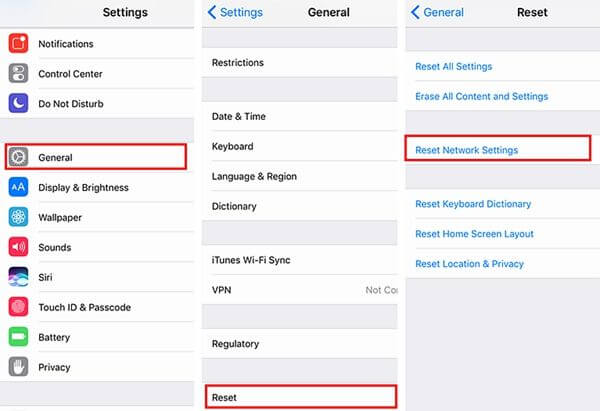
Tip:
Using Wi-Fi to update the iPhone is preferred over using cellular data because it's usually more stable, takes less time, and does not cause extra charge. If your iPhone cannot update in one network, try to switch to another one. It may work.
4. Restart or Force Restart Your iPhone
If your iPhone still encounters update problems after the basic settings, such as being stuck in a process, no reaction, frozen screen, etc., try to restart or force restart your iPhone to fix some system errors.
How to restart your iPhone
- If your iPhone is iPhone XR or newer: press and hold either the volume button or the side button simultaneously, and then "slide to power off" accordingly. After the shutdown, long press the slide button to turn on the phone.
How to force restart your iPhone
- If your iPhone is iPhone XR or newer: press and quickly release the volume up button, then do the same to the volume down button, and then long press the side button until the Apple logo appears.

5. Manually Upgrade to iOS 18
If your iPhone cannot update to iOS 18 automatically or is stuck in verifying installation, try to manually process the upgrade.
How to manually download/ install iOS 18
Step 1. Go to Settings > General > Software Update. Often there is a notice in red telling you that there is an iOS update available.
Step 2. At the bottom, there should be an "Upgrade to iOS 18" option. Select it and then tap Update Now to install iOS 18 on your iPhone.

Tip:
Once you have turned off the "Automatic Updates", your iPhone won't update itself until you download and install it manually. You can turn on "Automatic Updates" for the automatic download or both download and install next time.
How to manually delete the update file and reinstall it
Things may happen like your phone showing that it fails on your update verifying and it doesn't work when you keep tapping "Retry". At this time, you may have downloaded the iOS update file and there is something wrong with it. Try to delete it and download the update file again.
Step 1. Tap Setting > iPhone Storage.
Step 2. Find out the update file with a gear icon in the apps below.
Step 3. Select the file and choose "Delete Update".
Step 4. Go back to Settings > General > Software Update to reinstall iOS 18.
6. Upgrade to iOS 18 with a Computer
If you fiddle with your iPhone again and again and it still fails to update, there is still a way: upgrade your phone to iOS 18 with a computer.
The computer can be Windows or Mac. For macOS 10.15 or later, you can use Finder to upgrade. For macOS 10.14 or older or Windows systems, iTunes will be available for update.
Here we will take using iTunes as an example, and the way using Finder is similar:
Step 1. Launch iTunes (newest version).
Step 2. Plug your iPhone into the computer. Using the original charging cable to connect is recommended.
Step 3. Select the iPhone icon.
Step 4. Click "Check for Update" to find the iOS 18 update.
Step 5. Click "Download and Update" to install iOS 18 on your phone.
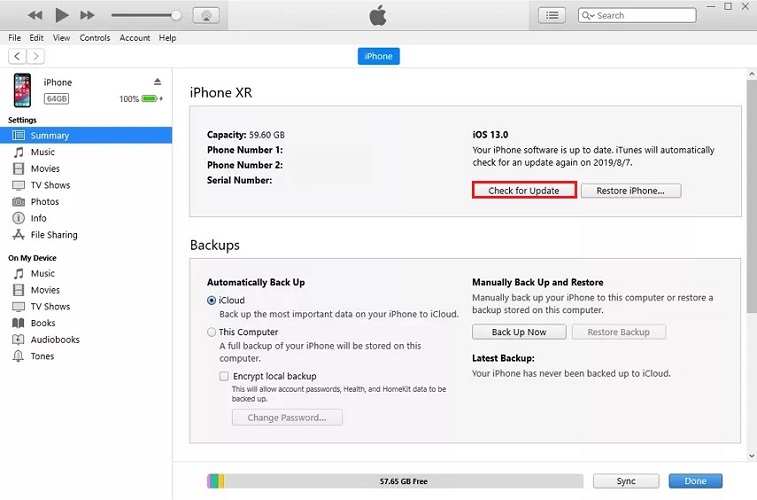
7. Reset or Restore Your iPhone for Update
Unfortunately, the methods above may not work and you have to come to this way. It is likely that there are some system or program problems on your phone, so you should try some ways to hard reset.
Before trying to fix the iPhone won't update problem with the ways below, do remember to back up your iPhone, because your iPhone data will be cleared. If you don't want to try the ways manually, skip to the next method which is using a third-party iOS system recovery program to help.
How to reset all settings with your iPhone
This method is to clear all settings and contents in your iPhone to fix some iOS system problems.
Step 1. Tap Settings > General > Reset > Reset All Settings.
Step 2. Turn on your phone and try to update to iOS 18 again.
How to restore your iPhone with your computer
As for this method, you have to use your computer for the restoration, and the latest version of iTunes is required. Here's the guide:
Step 1. Launch iTunes.
Step 2. Connect your iPhone to the computer with the lighting cable.
Step 3. Select the iPhone icon.
Step 4. Click "Restore iPhone". Again, this will clear all the data in your phone.
Step 5. After restoring, turn on your phone and try to update again.
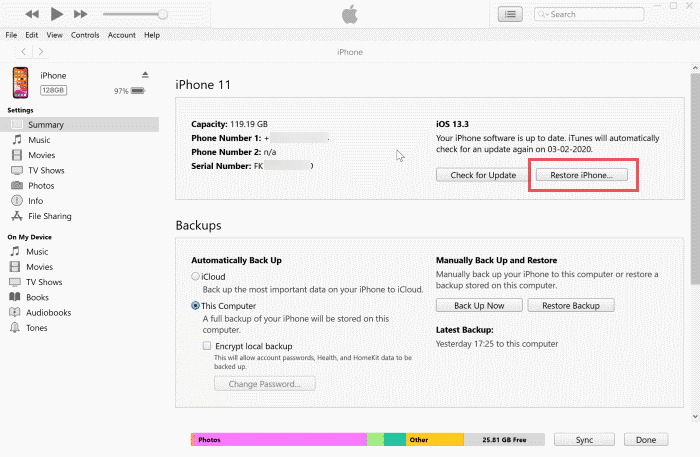
How to restore and update your iPhone in Recovery Mode
Recovery Mode is a mode that allows you to restore your iPhone as well as update your firmware to the latest version. This way is more forceful than just resetting your phone and can deal with problems like your computer not being able to verify your iPhone or your iPhone screen stuck on an Apple logo. What you need to do is:
Step 1. Launch iTunes.
Step 2. Connect your iPhone to the computer with the lighting cable.
Step 3. Turn on the recovery mode of your iPhone (pressing the buttons in the same way as force-restarting the iPhone, but if you enter the recovery mode successfully, your screen will turn black, showing the lighting cable plugging into the iTunes logo).
Step 4. iTunes will automatically detect your device and then a notice window pops up.
Step 5. Choose "Update" to update your phone to iOS 18.
Step 6. Exit the recovery mode after the update finishes (the same way as entering recovery mode).

8. Fix Update Problems and Upgrade with iOS System Recovery Software
Sometimes using a third-party iOS system recovery program to fix the iPhone-won't-update problem is much easier and more time-saving than trying different ways again and again by yourself. Here we recommend Passvers iOS System Recovery for you.
Passvers iOS System Recovery is helpful when you want to solve various iOS system problems including iOS update failure. To solve the iPhone won't update problem, this tool can provide you with easy and clear instructions for you to successfully update your iOS system in a few clicks. It provides three different recovery modes to fix your iOS problems, which are quick recovery mode (free), standard mode, and advanced mode, which can usually help you out in minutes without any data loss.
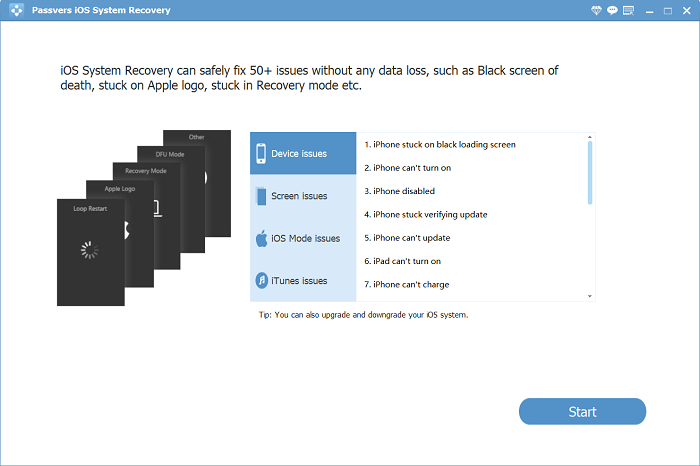
Part 2. How to Downgrade iPhone System After Update
Unfortunately, your iPhone may not function well after the update, or you really cannot get accustomed to the new iOS system. There is still a way to try – downgrade your iPhone system.
However, think twice before you downgrade, because it will also erase your iPhone. Always remember to back up when you are going to do something that will affect your phone data. Also, the old iOS system available for downgrading is very limited, for the reason that Apple usually disables the sign of the old iOS version soon after an update is released.
If you really make the decision to downgrade, follow the steps below:
1. Preparations for iOS System Downgrade
- Your iPhone
- A Computer with the latest iTunes installed
- The old iOS firmware with signed IPSWs, you can look up and download at https://ipsw.me/
2. Downgrade iOS System with iTunes
Step 1. Launch iTunes.
Step 2. Turn off "Find My iPhone" at Settings > Profile at the top > Find My > Find My iPhone.
Step 3. Connect your iPhone to iTunes with the charging cable.
Step 4. Select the iPhone icon.
Step 5. Press "Shift" (for Windows)/ "Option" (for Mac) and click "Restore iPhone" at the same time.
Step 6. Choose the firmware to downgrade the phone.
Notice:
Be very careful when you downgrade your iPhone. Keep the cable connected and do not do something else to your phone, because mistaken operation can lead to a brick iPhone.
If you think it hard to downgrade your iPhone manually, you can also seek help from a third-party program like Passvers iOS System Recovery, which can give you clear guidance and do most of the jobs for you.
Hope this passage can help you solve the iPhone won't update problem. If you have more concerns, feel free to contact us.